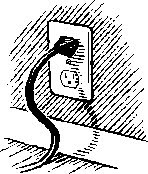Sunday's (9/27/09) New York Times (Sunday Business) - Solar Power, Without All those Panels is a very interesting advance in the use of photovoltaic cells and one I would like to see more use of. It seems to me that the use of solar power as a distributed generation alternative, rather than a central station alternative, is best use and best practices.
Home builders are including "building integrated photovoltaics" in roof tiles that will generate power directly into the home. The article provides an example of one product, installed in a California home, that will generate 2,400 kilowatt-hours per year for about 300 square feet of roofing tiles that contain photovoltaic cells. If you use about 1000 kilowatt-hours per month, this will reduce your consumption of central station power by 20%. That is a huge reduction in consumption and, if universally applied, would reduce the need for new power plants and transmission lines in the U.S. very significantly. It might also shift some of our electricity consumption from central station power plants from periods of peak consumption into off-peak periods because the solar roofs would be generating power when we need it most: at the peak time of day when the sun is shining, hottest temperatures and peak air conditioning consumption.
This fits very well with the concept I propose in my book (How to Tell a BTU from a BLT): Conservation Without Deprivation!
Sunday, September 27, 2009
Sunday, September 13, 2009
The Modular, Scalable Nuclear Reactor
Anyone who has been involved in the engineering design and construction of a new nuclear power plant will admit the process is long, risky (financially) and with too much government red tape and delays. They will also tell you that as a result, you only get one shot at building a nuke--so build it big. The latest crop of nuclear power plant designs are 1,100 MWe (Westinghouse/Toshiba) and an astounding 1,700 MWe (Mitshubishi Heavy Industries).
Along comes Babcock & Wilcox (a company well experienced in electric power and with a big nuclear design of its own when the first 104 U.S. Nukes were developed) with mPower, a modular, scalable nuclear plant that comes in sizes ranging from 125 MWe to 750MWe. These designs are safer than the existing fleet and the newer designs because the configuration is such that it eliminates the worst design basis accident that is postulated: the LOSS OF COOLANT ACCIDENT or LOCA. The existing fleet and the newer nuclear offerings have to be designed to withstand a break in the main piping that cools the reactor core--LOCA. Much of the regulatory angst and engineering challenges surround this hypothetical accident.
B&W's design is different. It is totally self contained and, therefore, does not include the system (Reactor Coolant Loop) that requires engineers to worry about its breaking. The other advantages are reduced regulatory requirements, only a three year construction cycle and a five year refueling cycle, meaning the utility only has to replace the nuclear fuel every five years, instead of every 18 months prevalent today.
The other obvious advantages are that smaller utilities can take advantage of nuclear power because it can be built in smaller, more affordable increments in much less time than the big units. In addition, it can be built in smaller pieces providing system flexibility. A small utility cannot afford to lose 1000 MWe of power when a plant has a forced outage if it only has a 4000 MWe system. So it can't build plants that are so big. However, if it can build 125 MWe or 25o MWe, the system can maintain its flexibility and reliabilty if a unit is forced out of service.
This is the type of nuclear plant innovation that will allow the U.S. to achieve the long process of weaning itself off of polluting fossil fuels.
Along comes Babcock & Wilcox (a company well experienced in electric power and with a big nuclear design of its own when the first 104 U.S. Nukes were developed) with mPower, a modular, scalable nuclear plant that comes in sizes ranging from 125 MWe to 750MWe. These designs are safer than the existing fleet and the newer designs because the configuration is such that it eliminates the worst design basis accident that is postulated: the LOSS OF COOLANT ACCIDENT or LOCA. The existing fleet and the newer nuclear offerings have to be designed to withstand a break in the main piping that cools the reactor core--LOCA. Much of the regulatory angst and engineering challenges surround this hypothetical accident.
B&W's design is different. It is totally self contained and, therefore, does not include the system (Reactor Coolant Loop) that requires engineers to worry about its breaking. The other advantages are reduced regulatory requirements, only a three year construction cycle and a five year refueling cycle, meaning the utility only has to replace the nuclear fuel every five years, instead of every 18 months prevalent today.
The other obvious advantages are that smaller utilities can take advantage of nuclear power because it can be built in smaller, more affordable increments in much less time than the big units. In addition, it can be built in smaller pieces providing system flexibility. A small utility cannot afford to lose 1000 MWe of power when a plant has a forced outage if it only has a 4000 MWe system. So it can't build plants that are so big. However, if it can build 125 MWe or 25o MWe, the system can maintain its flexibility and reliabilty if a unit is forced out of service.
This is the type of nuclear plant innovation that will allow the U.S. to achieve the long process of weaning itself off of polluting fossil fuels.
Subscribe to:
Comments (Atom)



